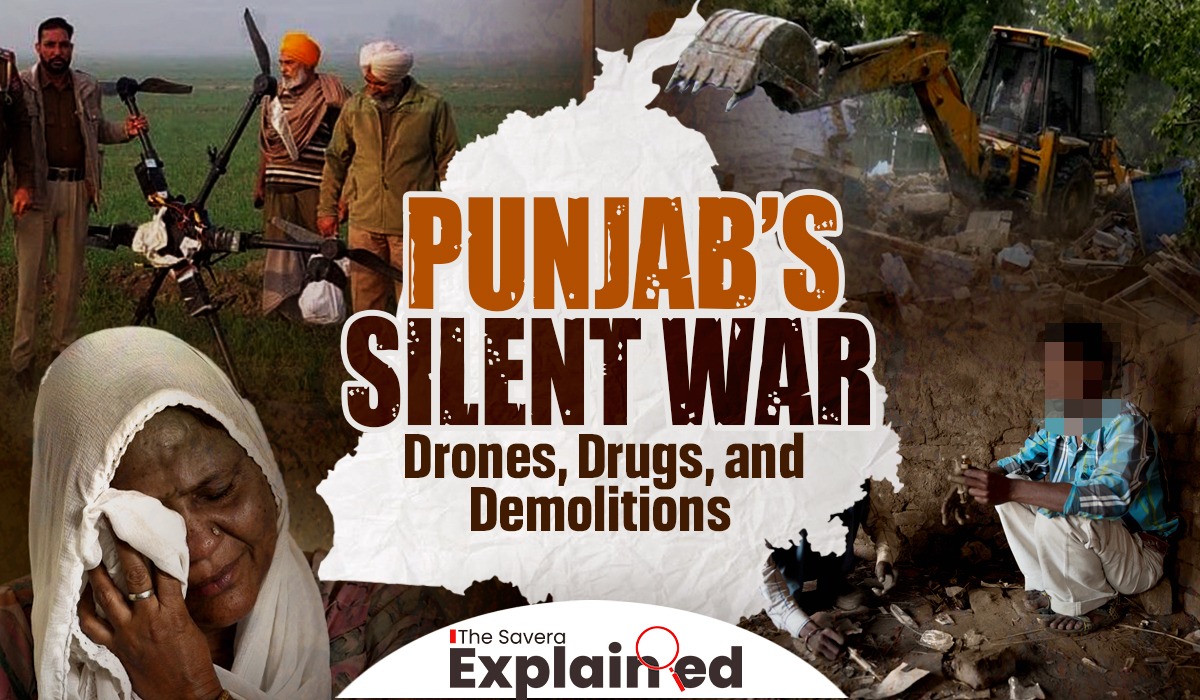Jalandhar: Punjab, once celebrated as India’s breadbasket, is now grappling with a grim reality: a spiraling drug trafficking crisis that has entrenched itself as a generational tragedy.
Situated along the India-Pakistan border, the state’s strategic location near the Golden Crescent—comprising Afghanistan, Pakistan, and Iran—has made it a prime conduit for illicit narcotics, particularly heroin.
The surge in drug smuggling, intensified in recent years. These activities are likely to be aimed at disrupting cross-border networks, with sophisticated methods like drone deliveries.
This escalation has fueled an alarming rise in drug addiction among Punjab’s youth, with devastating ripple effects across neighboring states like Haryana and Himachal Pradesh.
Daily reports of drone interceptions underscore the relentless flow of narcotics, causing an increase in crime cases in the state.
The recent state-level law and order review meeting in Phillaur, led by Director General of Police (DGP) Gaurav Yadav, highlighted the scale of the issue and the aggressive measures being taken to combat it.
These measures have been taken under the Yudh Nasha Virudh Yojana.
Highlights of the Meeting
- Campaign Achievements: Since March 1, 2025, ‘Yudh Nashian Virudh’ registered 14,281 FIRs, arrested 22,772 smugglers, and seized 940 kg heroin, 337 kg opium, and ₹11.84 crore in drug money.
- Safe Punjab Helpline: The WhatsApp Chatbot (9779100200) achieved a 30% tip conversion rate, leading to 3,671 FIRs and 4,872 arrests.
- Crime Resolution: 100% terror cases solved; all major organized crime cases traced.
- Conviction Rates: 90% conviction rate in NDPS Act cases since March 2025.
- Public Engagement: DGP Yadav urged anonymous reporting of drug traffickers via the helpline.
- Bulldozer Action and Property Demolitions: Since March 2025, 126 illegal properties linked to drug smugglers have been demolished, including 60 in four days (March 1–4, 2025).
Youth Drug Addiction in Punjab
- Prevalence: A 2022 study by the Postgraduate Institute of Medical Education and Research (PGIMER) estimates 15% of Punjab’s 27.74 million population (approximately 4.1 million people) use drugs, with 70% of addicts aged 15–30. A 2015 Punjab Opioid Dependence Survey (PODS) found 76% of opioid users are aged 18–35, with 4 in 100 males in this age group being opioid-dependent.
- Primary Substances: Heroin, locally called “chitta,” is the most abused drug, used by 67% of addicts in a 2020 study, followed by other opioids (15%) and alcohol (8%). Intravenous drug use is prevalent, with 51% of addicts injecting drugs, increasing HIV risks.
- Contributing Factors: Unemployment, peer pressure, and easy drug access drive addiction. Rural areas report higher substance abuse (65.5% prevalence) due to socioeconomic challenges and proximity to smuggling routes.
Drone Recoveries and Smuggling Trends
- Drone Recoveries: In 2024, the Border Security Force (BSF) recovered 294 drones, up from 107 in 2023, reflecting increased smuggling via smaller drones carrying 500g heroin payloads to minimize losses. From October 28–30, 2023, six drones were seized in Amritsar, Tarn Taran, and Ferozepur.
- Heroin and Arms Seizures: In 2024, BSF seized 283 kg of heroin, while Punjab Police confiscated 322 kg of heroin and Rs. 2.73 crore in cash from July 2024 to March 2025. Between July 2022 and June 2023, 1,135.25 kg of heroin was seized. Arms recoveries, often tied to narco-terrorism, included small arms smuggled alongside drugs.
- Smuggling Tactics: Post-Operation Sindoor, smugglers shifted to drones to evade tightened border controls, exploiting weak fence points and collaborating with Pakistan’s ISI. This has sustained a robust supply chain despite crackdowns.
Ease of Drug Availability
- Cross-Border Supply: Punjab’s 553-km border with Pakistan facilitates heroin smuggling from Afghanistan, with drugs entering via drones, tunnels, or thrown packets. In 2020, 75% of India’s drug seizures occurred in Punjab.
- Local Distribution: Heroin costs Rs. 4,000–6,000 per gram in Punjab, cheaper than in other states (Rs. 1 crore/kg), encouraging local consumption. Addicts often turn to peddling, creating a self-sustaining cycle.
- Systemic Challenges: Corruption, limited rehab facilities (50 government vs. 90 private centers), and low de-addiction success rates (1.5% in government centers) hinder efforts. Adulterated drugs increase overdose risks, with 190 deaths reported since March 2022.

